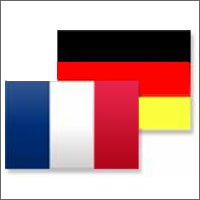France and Germany: in the ERA driving seat
The Franco-German axis is regarded by many as being at the heart of the European Union, and the two countries were certainly instrumental in the establishment of the EU's predecessor, the European Economic Community (EEC). One could also argue that the Franco-German engine has been driving research collaboration. Along with the UK they are the most enthusiastic participants in the EU's framework programmes for research, and have committed to a wide range of bilateral research organisations and projects since the end of the Second World War. Some of history's best scientific brains, from Alexander von Humboldt and Albert Einstein to Paul Langevin and Max Planck, had been working alongside their French or German counterparts prior to the war. But the events of 1939 to 1945 ended all contacts, and it was a while before collaborative working relationships were re-established. Once the first links were made, and the first organisations created, Franco-German initiatives mushroomed. The two countries continue to work very closely today, bilaterally as well as in an EU context. Political rapprochement had to first clear the way for scientists to make contact with one another. Once progress was made here, thanks to men such as Konrad Adenauer, Robert Schuman, Jean Monnet and Charles de Gaulle, collaborative research was again a possibility. In 1949, 170 personalities from Europe's cultural and intellectual communities gathered in Lausanne in Switzerland, and heard French physics Nobel laureate Louis de Broglie call on Europe's academics to work together. The result was the now world-renowned European Council for Nuclear Research (CERN), established in 1954 and still going strong today. This was followed closely by the Franco-German Research Institute in St. Louis (ISL), for security and defence research. Given that France and Germany had only just put down their arms, security and defence were not the obvious fields for cooperation. The idea was first broached by a group of German scientists with expertise in ballistics and aerodynamics. After the end of the war, the scientists wanted to work for the French Government. Having made the appropriate contacts, they established themselves in the small town of St. Louis in southern Alsace. The location was ideal as, located only 4km from Germany, it allowed the scientists to work in France, but live in their home country. By the end of the 1950s, both governments had agreed to formalise the arrangement, and to create a bilateral institution. The ISL is still based in St. Louis today. It has two directors - one French and one German - and around 400 staff, just less than half of which are researchers. French director Alain Picq told CORDIS News that he sees the ISL as 'a strong political symbol of Franco-German reconciliation'. He also believes that bilateral initiatives such as this are a way of strengthening research in the EU. The institute has expertise in detonics, ballistics, high-velocity measurements, sensors, acoustics (for detecting snipers), lasers, nanomaterials and improvised explosive devices (IEDs). Last year the institute adopted a new strategy focusing on dual use applications for defence against terrorism. The ISL is well-known in its domain, and has major contracts with the French and US armies. But Mr Picq would like to see the ISL's visibility raised in Europe. The new strategy also outlines the goals of raising the institute's profile within the European security and defence community, strengthening cooperation agreements and networking. Mr Picq also intends to see the ISL participating in the EU's Seventh Framework Programme (FP7), and working more closely with the European Defence Agency (EDA). 'Our priorities are clearly within the EU,' he says. While the ISL has stuck to its roots and remained primarily a Franco-German initiative, there are also examples of French-German projects that have broadened their scope to become European projects. The Institut Laue-Langevin (ILL) is one such project. Based in Grenoble, the ILL operates the most intense neutron source in the world, together with a suite of 40 high-performance instruments, which are used to investigate the content matter of solids, new materials, biological materials, new substances and nanotechnology materials. The ILL is celebrating its 40th birthday this year. It was founded as a direct result of discussions between French President Charles de Gaulle and German Chancellor Konrad Adenauer, following a proposal from scientists. The UK became a third associate member in 1973, and the institute now has 10 scientific partners who provide the funding between them. The ILL has 'changed tremendously' since its conception in 1967, says its director Richard Wagner. With partners from Austria, Belgium, the Czech Republic, Hungary, Italy, Spain, Poland, Russia, Sweden and Switzerland, the ILL has 'developed into a truly European research institute,' Professor Wagner told CORDIS News. Professor Wagner sees both France and Germany as playing a major role in the development of the European Research Area (ERA) - an initiative he describes as being of 'major importance'. The ILL has not only led to the establishment of links between the scientific communities in the countries involved, but has encouraged bilateral cooperation between institutes around Europe 'beyond Grenoble'. The ILL is set to become yet more 'European', having been included on the list of 35 priority projects drafted by the European Strategy Forum on Infrastructures (ESFRI). In this context the ILL will be applying for funding under FP7, and Professor Wagner is feeling 'pretty optimistic'. The institute is planning seven new instruments for emerging fields in the coming years. Evidence so far suggests that established links between France and Germany are ties that bind. And as both countries remain at the forefront of research in many scientific fields, collaboration between the neighbours makes perfect sense. If this means the Franco-German engine driving research collaboration, this can only be a good thing for the rest of Europe.
Countries
Germany, France

